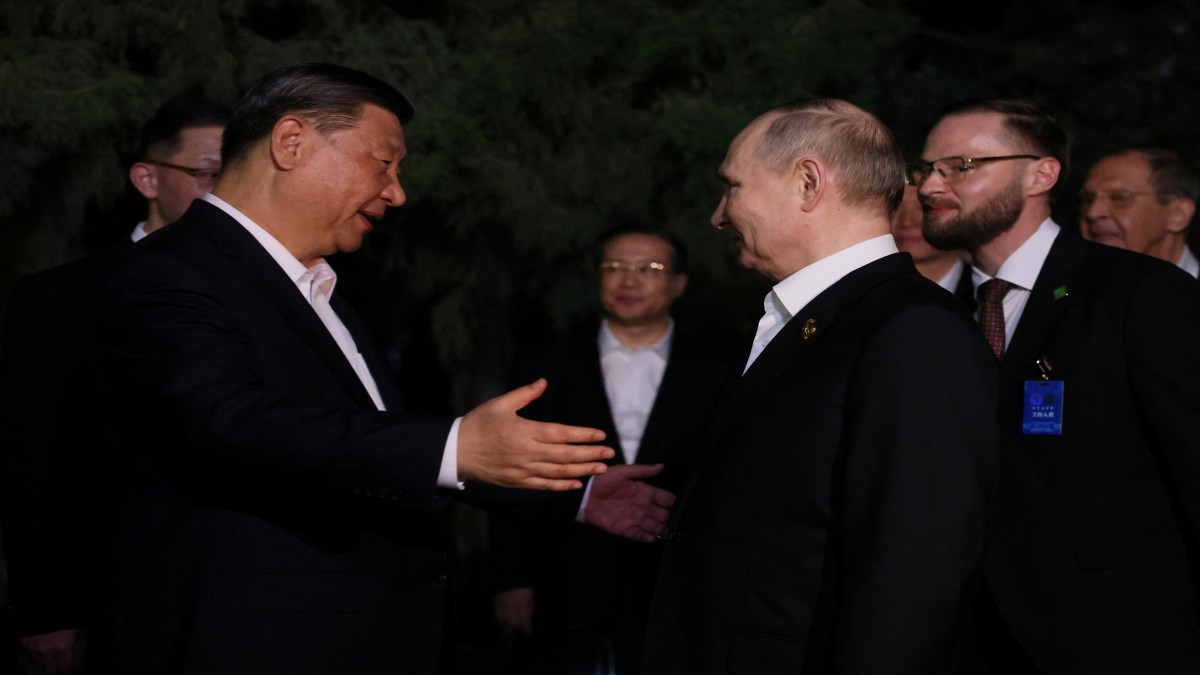The recent visit of Russian President Vladimir Putin to China and the summit meeting between two strongmen of China and Russia hold considerable significance for the Indian strategic community to reflect upon and examine its long-term implications for India’s foreign policy goals.
Russia has been a time-tested security partner of India, despite India’s all-encompassing strategic partnership with the United States. Earlier during the Cold War years, India was the former Soviet Union’s closest security partner among the developing countries when New Delhi and Washington maintained an estranged relationship.
As the Cold War ended and Russia emerged out of the former Soviet Union as a weaker power with a diminished role in world affairs, the length and breadth of the Indo-Russian relationship dropped, while India and the US slowly but steadily came closer to each other. Moscow fumed when the US began to enlarge its presence in India’s arms bazaar, and Washington aimed at shrinking Russian sales of weapons to India, which was rapidly expanding its military modernization and arms acquisition. India, however, sought to maintain its autonomous decision-making in arms purchases and sources of acquisitions.
Russia sold certain military equipment, including missiles, at critical times, such as Chinese muscle flexing along the line of actual control, and the US dangled but did not resort to sanctions against India. On the other hand, India purchased a huge amount of Russian oil amidst the war in Ukraine and did so in the face of American protestations. The Indian government’s decision helped India secure its energy requirements, helped Russia economically at a time of massive Western sanctions, and did not harm US interests.
Unlike Russia-Indian relations, Sino-Indian relations are competitive, transactional, and, in the long run, rivalry-prone. India and China compete for influence in the Global South, continue their trade relations despite violent clashes along the border, and in the long run, a rising India is perceived as a challenge to Chinese aspirations for hegemony in the Indo-Pacific region.
Impact Shorts
More ShortsThus, the future of Sino-Indian relations will certainly be affected by the nature, depth, and expanse of the Russo-Chinese relationship. The outcome of the recent Putin-Xi summit indicates that the two countries have cemented their long-term strategic ties that will seek to confront the US-led global order, write new rules of international engagements, and also expand and consolidate their presence and influence in various parts of the world.
There are analysts who perceive the emerging Russo-Chinese partnership as a short-term phenomenon where China maintains official neutrality in the Ukraine War, but its actions bolster Russia’s strength to continue its war in the Ukraine War. They think that once the war in Ukraine is over, China will renew with vigour its economic connectivity with the West and aspire to be a superpower where Russia, at best, can be a junior partner.
However, no one knows how the Ukraine War will end—with Russian victory or American victory? Ukraine will be the losers under any arrangement! American victory will abate China’s resolve to annex Taiwan by force, if needed. The Russian triumph will surely weaken US influence in a new world order where China will reap the benefits but cannot view Russia as a junior partner. In a long span of world history, Russia and China have been allies, adversaries, competitors, and co-partners.
It is cumbersome to visualise the distant scenario, but in the foreseeable future, Russia and China will be strong strategic partners seeking to reorder the global security architecture to blunt the US’ primacy. This is where Indian strategic thinkers have to analyse the strategic course of action that India needs to adopt to secure its future role in world affairs.
Russia will not compromise on its control over Crimea, its gains in Ukraine, and its influence over Georgia. China will never give up on Taiwan and the South China Sea Islands and will surely try to preserve its BRI projects. And the US is perceived by Putin and Xi, and rightly so, as the real threat to their interests. They call the US the ‘destabiliser’ of the global order. The North Korean and Iranian leadership are increasingly inching towards forming a counter-‘Quad’ along with China and Russia.
It is worthwhile to analyse the embryonic potential scenarios. One such scenario could be a subtle competition between the current Quad consisting of the US, India, Japan, and Australia and the emerging Quad consisting of Russia, China, North Korea, and Iran. What will be the Russian position if China yet again upends its aggressive movements along the Sino-Indian border?
In another scenario, India could revive the Russia-China-India triangle and, along with BRICS and the Shanghai Cooperation Organisation, aim to promote a multilateral world order. What will be its impact on the India-US strategic partnership and the Quad partners?
The third scenario can be an extremely multifaceted Cold War where there will be no watertight alliances or unbreakable commitments, and the foreign policies of the member countries will keep mutating their policies and approaches, like company shares in a stock market.
The best course of action for India perhaps would be not ‘Ekla Chalo’ under the rhetoric of strategic autonomy but to carefully study the strategic market place and position itself flexibly on issues and events. The evolving global political chessboard is in rapid flux, and there will be a few quick fixes available. India needs to reorganise its engagements with Russia, China, and the US to start with.
The writer is founder chairperson of Kalinga Institute Indo-Pacific Studies and former Professor at JNU. Views expressed in the above piece are personal and solely those of the author. They do not necessarily reflect Firstpost’s views.


)

)
)
)
)
)
)
)
)



